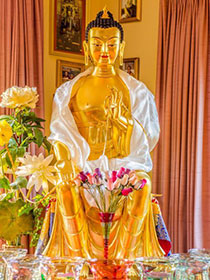- Home
- FPMT Homepage
Foundation for the Preservation of the Mahayana Tradition
The FPMT is an organization devoted to preserving and spreading Mahayana Buddhism worldwide by creating opportunities to listen, reflect, meditate, practice and actualize the unmistaken teachings of the Buddha and based on that experience spreading the Dharma to sentient beings. We provide integrated education through which people’s minds and hearts can be transformed into their highest potential for the benefit of others, inspired by an attitude of universal responsibility and service. We are committed to creating harmonious environments and helping all beings develop their full potential of infinite wisdom and compassion. Our organization is based on the Buddhist tradition of Lama Tsongkhapa of Tibet as taught to us by our founders Lama Thubten Yeshe and Lama Thubten Zopa Rinpoche.
- Willkommen
Die Stiftung zur Erhaltung der Mahayana Tradition (FPMT) ist eine Organisation, die sich weltweit für die Erhaltung und Verbreitung des Mahayana-Buddhismus einsetzt, indem sie Möglichkeiten schafft, den makellosen Lehren des Buddha zuzuhören, über sie zur reflektieren und zu meditieren und auf der Grundlage dieser Erfahrung das Dharma unter den Lebewesen zu verbreiten.
Wir bieten integrierte Schulungswege an, durch denen der Geist und das Herz der Menschen in ihr höchstes Potential verwandelt werden zum Wohl der anderen – inspiriert durch eine Haltung der universellen Verantwortung und dem Wunsch zu dienen. Wir haben uns verpflichtet, harmonische Umgebungen zu schaffen und allen Wesen zu helfen, ihr volles Potenzial unendlicher Weisheit und grenzenlosen Mitgefühls zu verwirklichen.
Unsere Organisation basiert auf der buddhistischen Tradition von Lama Tsongkhapa von Tibet, so wie sie uns von unseren Gründern Lama Thubten Yeshe und Lama Thubten Zopa Rinpoche gelehrt wird.
- Bienvenidos
La Fundación para la preservación de la tradición Mahayana (FPMT) es una organización que se dedica a preservar y difundir el budismo Mahayana en todo el mundo, creando oportunidades para escuchar, reflexionar, meditar, practicar y actualizar las enseñanzas inconfundibles de Buda y en base a esa experiencia difundir el Dharma a los seres.
Proporcionamos una educación integrada a través de la cual las mentes y los corazones de las personas se pueden transformar en su mayor potencial para el beneficio de los demás, inspirados por una actitud de responsabilidad y servicio universales. Estamos comprometidos a crear ambientes armoniosos y ayudar a todos los seres a desarrollar todo su potencial de infinita sabiduría y compasión.
Nuestra organización se basa en la tradición budista de Lama Tsongkhapa del Tíbet como nos lo enseñaron nuestros fundadores Lama Thubten Yeshe y Lama Zopa Rinpoche.
A continuación puede ver una lista de los centros y sus páginas web en su lengua preferida.
- Bienvenue
L’organisation de la FPMT a pour vocation la préservation et la diffusion du bouddhisme du mahayana dans le monde entier. Elle offre l’opportunité d’écouter, de réfléchir, de méditer, de pratiquer et de réaliser les enseignements excellents du Bouddha, pour ensuite transmettre le Dharma à tous les êtres. Nous proposons une formation intégrée grâce à laquelle le cœur et l’esprit de chacun peuvent accomplir leur potentiel le plus élevé pour le bien d’autrui, inspirés par le sens du service et une responsabilité universelle. Nous nous engageons à créer un environnement harmonieux et à aider tous les êtres à épanouir leur potentiel illimité de compassion et de sagesse. Notre organisation s’appuie sur la tradition guéloukpa de Lama Tsongkhapa du Tibet, telle qu’elle a été enseignée par nos fondateurs Lama Thoubtèn Yéshé et Lama Zopa Rinpoché.
Visitez le site de notre Editions Mahayana pour les traductions, conseils et nouvelles du Bureau international en français.
Voici une liste de centres et de leurs sites dans votre langue préférée
- Benvenuto
L’FPMT è un organizzazione il cui scopo è preservare e diffondere il Buddhismo Mahayana nel mondo, creando occasioni di ascolto, riflessione, meditazione e pratica dei perfetti insegnamenti del Buddha, al fine di attualizzare e diffondere il Dharma fra tutti gli esseri senzienti.
Offriamo un’educazione integrata, che può trasformare la mente e i cuori delle persone nel loro massimo potenziale, per il beneficio di tutti gli esseri, ispirati da un’attitudine di responsabilità universale e di servizio.
Il nostro obiettivo è quello di creare contesti armoniosi e aiutare tutti gli esseri a sviluppare in modo completo le proprie potenzialità di infinita saggezza e compassione.
La nostra organizzazione si basa sulla tradizione buddhista di Lama Tsongkhapa del Tibet, così come ci è stata insegnata dai nostri fondatori Lama Thubten Yeshe e Lama Zopa Rinpoche.
Di seguito potete trovare un elenco dei centri e dei loro siti nella lingua da voi prescelta.
- 欢迎 / 歡迎
简体中文
“护持大乘法脉基金会”( 英文简称:FPMT。全名:Foundation for the Preservation of the Mahayana Tradition) 是一个致力于护持和弘扬大乘佛法的国际佛教组织。我们提供听闻,思维,禅修,修行和实证佛陀无误教法的机会,以便让一切众生都能够享受佛法的指引和滋润。
我们全力创造和谐融洽的环境, 为人们提供解行并重的完整佛法教育,以便启发内在的环宇悲心及责任心,并开发内心所蕴藏的巨大潜能 — 无限的智慧与悲心 — 以便利益和服务一切有情。
FPMT的创办人是图腾耶喜喇嘛和喇嘛梭巴仁波切。我们所修习的是由两位上师所教导的,西藏喀巴大师的佛法传承。
繁體中文
護持大乘法脈基金會”( 英文簡稱:FPMT。全名:Found
ation for the Preservation of the Mahayana Tradition ) 是一個致力於護持和弘揚大乘佛法的國際佛教組織。我們提供聽聞, 思維,禪修,修行和實證佛陀無誤教法的機會,以便讓一切眾生都能 夠享受佛法的指引和滋潤。 我們全力創造和諧融洽的環境,
為人們提供解行並重的完整佛法教育,以便啟發內在的環宇悲心及責 任心,並開發內心所蘊藏的巨大潛能 — 無限的智慧與悲心 – – 以便利益和服務一切有情。 FPMT的創辦人是圖騰耶喜喇嘛和喇嘛梭巴仁波切。
我們所修習的是由兩位上師所教導的,西藏喀巴大師的佛法傳承。 察看道场信息:
- FPMT Homepage
- News/Media
-
- Study & Practice
-
-
- About FPMT Education Services
- Latest News
- Programs
- New to Buddhism?
- Buddhist Mind Science: Activating Your Potential
- Heart Advice for Death and Dying
- Discovering Buddhism
- Living in the Path
- Exploring Buddhism
- FPMT Basic Program
- FPMT Masters Program
- FPMT In-Depth Meditation Training
- Maitripa College
- Lotsawa Rinchen Zangpo Translator Program
- Universal Education for Compassion & Wisdom
- Online Learning Center
-
- Prayers & Practice Materials
- Overview of Prayers & Practices
- Full Catalogue of Prayers & Practice Materials
- Explore Popular Topics
- Benefiting Animals
- Chenrezig Resources
- Death & Dying Resources
- Lama Chopa (Guru Puja)
- Lama Zopa Rinpoche: Compendium of Precious Instructions
- Lama Zopa Rinpoche: Life Practice Advice
- Lama Zopa Rinpoche Practice Series
- Lamrim Resources
- Mantras
- Prayer Book Updates
- Purification Practices
- Sutras
- Thought Transformation (Lojong)
- Audio Materials
- Dharma Dates - Tibetan Calendar
- Translation Services
- Publishing Services
- Ways to Offer Support
- Prayers & Practice Materials
-
- Teachings and Advice
- Find Teachings and Advice
- Lama Zopa Rinpoche Advice Page
- Lama Zopa Rinpoche: Compendium of Precious Instructions
- Lama Zopa Rinpoche Video Teachings
- ༧སྐྱབས་རྗེ་བཟོད་པ་རིན་པོ་ཆེ་མཆོག་ནས་སྩལ་བའི་བཀའ་སློབ་བརྙན་འཕྲིན།
- Podcasts
- Lama Yeshe Wisdom Archive
- Buddhism FAQ
- Dharma for Young People
- Resources on Holy Objects
- Teachings and Advice
-
-
*If a menu item has a submenu clicking once will expand the menu clicking twice will open the page.
-
-
- Centers
-
- Teachers
-
- Projects
-
-
-
-
*If a menu item has a submenu clicking once will expand the menu clicking twice will open the page.
-
-
- FPMT
-
-
-
-
-
Live with compassion. Work with compassion. Die with compassion. Meditate with compassion. Enjoy with compassion. When problems come, experience them with compassion.
Lama Zopa Rinpoche
-
-
-
- Shop
-
-
-
The Foundation Store is FPMT’s online shop and features a vast selection of Buddhist study and practice materials written or recommended by our lineage gurus. These items include homestudy programs, prayers and practices in PDF or eBook format, materials for children, and other resources to support practitioners.
Items displayed in the shop are made available for Dharma practice and educational purposes, and never for the purpose of profiting from their sale. Please read FPMT Foundation Store Policy Regarding Dharma Items for more information.
-
-
Lama Zopa Rinpoche News and Advice
5
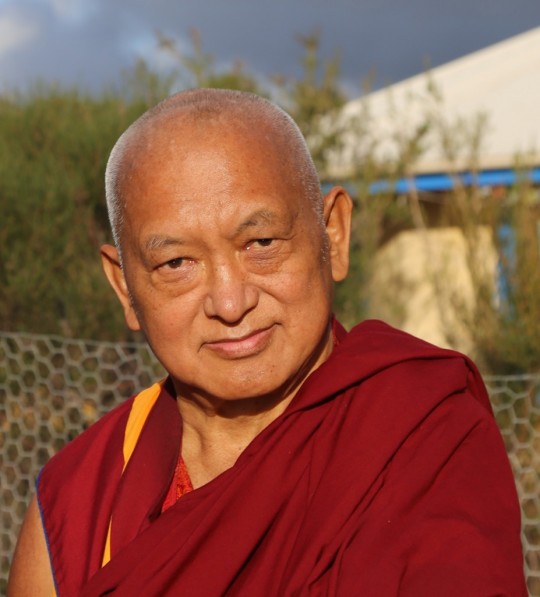
Lama Zopa Rinpoche, De-Tong Ling Retreat Centre, Australia, May 2015. Photo by Ven. Thubten Kunsang.
During a 1991 talk in Adelaide, Australia, Lama Zopa Rinpoche responded to a question about low self-esteem with a teaching on the nature of the mind. Here’s a short excerpt from this talk, published by the Lama Yeshe Wisdom Archive:
“… What is the mind? It is nothing other than what is merely imputed by the mind, by the thought. In other words, because of the reason that the base – this formless phenomenon that is clear and perceives objects – exists, mind is merely labeled by the thought, and believed in. Because of this, thought makes up the idea, the concept, the label, ‘mind,’ and then believes in what is merely imputed by thought. Therefore, what the mind is, is extremely subtle. It does not exist in the way it normally appears to us. In reality, the mind that exists does not exist in the way that it normally appears to us, in the way we normally apprehend it, as a real mind existing from its own side, an inherently existent mind. It is not that.
“This formless phenomenon whose nature is clear and able to perceive objects, this is the base. Depending on this base, mind is labeled, so ‘mind’ is the label and that phenomenon is the base to be labeled. Therefore, the base and the label ‘mind’ have to be different; they cannot be one thing. There is no way that the base to be labeled and the label can be one. If this particular formless phenomenon that is clear and able to perceive objects were the label ‘mind,’ there would be no point in labeling mind. Why would you label ‘mind’? There is no reason to label ‘mind’ on the mind. This would become endless. You would label ‘mind’ on the mind, then you would have to label ‘mind’ on that mind, then again you would have to label ‘mind’ on that mind. It would become endless. There is no purpose in doing this.
“Generally, you apply a label to something that is not that. There is some purpose in doing this. For example, when you see your mother among a group of your relatives – your brother, sister, father, aunt, uncle, and so forth – what is the reason that makes you create the label ‘mother’? First you have to think about this. A reason comes in your mind before you make up the label ‘mother.’ Some reason makes you choose this particular label. …”
Read the entire teaching from Rinpoche at:
https://www.lamayeshe.com/article/ultimate-nature-mind
More information, photos and updates about FPMT spiritual director Lama Zopa Rinpoche can be found on Rinpoche’s webpage. If you’d like to receive news of Lama Zopa Rinpoche via email, sign up to Lama Zopa Rinpoche News.
- Tagged: lama zopa rinpoche
- 0
4

Lama Zopa Rinpoche with Ven. Dhundrup and Dale, the architect, going over the plans for a group retreat facility at Detong Ling Retreat Centre, Kangaroo Island, Australia.
Lama Zopa Rinpoche gave this translation of a Tibetan text on how to build a retreat house, published in November 2013 on the Lama Yeshe Wisdom Archive:
As requested by Pungsang, Buddha states how to make a meditation room:
On that land, dig the earth and purify the place. If the house depends on heat and warmth, put a mud wall around it. The door of the meditation house should face east, north or west, but never south. If there is downstairs and upstairs, at least one door should not face south. Put a window towards the south or the east.
A dedicated meditation room is auspicious for a good retreat and helps the mind remain undisturbed, as outer and inner conditions are dependent arisings. Having a dedicated room qualifies the place as suitable for abiding in the retreat. If it is not possible to find all the conditions, at least arrange what is most comfortable for the yogi to do retreat.
The second chapter of the Guhyasamaja Tantra states that in all the directions of the earth, in places of great isolation that are adorned with flowers and fruits; in the isolation of the mountain, all realizations will be achieved.
You can find more advice on retreat in “Lama Zopa Rinpoche’s Online Advice Book,” on the Lama Yeshe Wisdom Archive website (https://www.lamayeshe.com/).
Learn more about Lama Zopa Rinpoche, spiritual director of the Foundation for the Preservation of Mahayana Tradition (FPMT), and Rinpoche’s vision for a better world. Sign up to receive news and updates.
- Tagged: lama zopa rinpoche, retreat
- 0
3
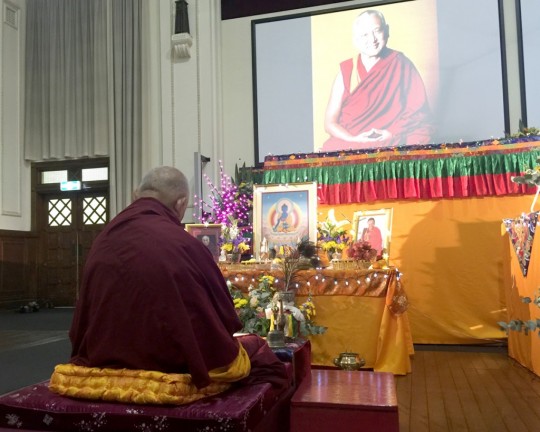
Lama Zopa Rinpoche doing preparation for Medicine Buddha jenang, Buddha House, Australia, May 2015. Photo by Ven. Thubten Kunsang.
“The seven Medicine Buddhas, attainers of bliss, strongly prayed for the temporal and ultimate happiness of yourself and all sentient beings. They vowed that their prayers would be actualized during these degenerate times when the teachings of Shakyamuni Buddha are in decline. As the buddhas’ holy speech is irrevocable, you can wholly trust in their power to quickly grant blessings to help all sentient beings in these degenerate times,” Lama Zopa Rinpoche instructs in “The Benefits of Medicine Buddha Mantra and Practice,” a free PDF created by FPMT Education Services. “If you pray to Guru Medicine Buddha, you will quickly accomplish all that you wish. Just hearing the holy name of Guru Medicine Buddha and the sound of his mantra closes the door to rebirth in the suffering lower realms. It is written in the scriptures that you should not have a two-pointed mind (doubt) with regard to these benefits. …”
“Therefore, at the time of death, it is excellent to recite both Tathagata Medicine Buddha’s holy name and his mantra in the ear of the dying person. It is extremely beneficial to recite the mantra and blow it upon meat that you are eating, or even on old bones or the dead bodies of animals or humans. This action purifies the karmic obscurations of those sentient beings. It can cause someone who has been reborn in the suffering lower realms to immediately pass away and be reborn in a pure realm or amongst happy transmigrators. At the very least, it will shorten the duration of their suffering in the lower realms. It is excellent if this is done with bodhichitta, renouncing self and cherishing others.
“Also, by reciting this mantra, you will greatly enhance the power of the medicine that you are taking or giving to others. …”
You can read the complete advice in the short booklet “The Benefits of Medicine Buddha Mantra and Practice,” a free PDF of FPMT Education Services.
FPMT Education Services has created many resources pages to help FPMT students learn more on these topics, including ones for “Mantras” and “Death and Dying: Heart Advice and Practices.”
Lama Zopa Rinpoche is the spiritual director of the Foundation for the Preservation of Mahayana Tradition (FPMT), a Tibetan Buddhist organization dedicated to the transmission of the Mahayana Buddhist tradition and values worldwide through teaching, meditation and community service.
- Tagged: lama zopa rinpoche, medicine buddha
- 0
1
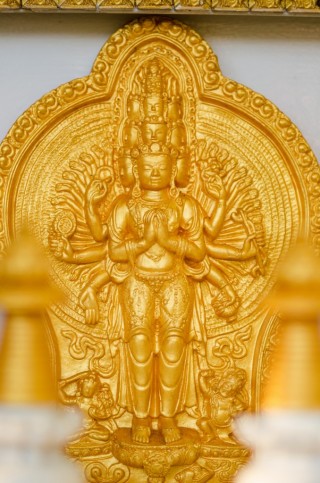
1000-Armed Chenrezig, Kachoe Dechen Ling, Aptos, California,November 2014. Photo by Chris Majors.
A student wrote Lama Zopa Rinpoche with a serious confession: “My forefathers have done very heinous sins, which is the major cause of suffering in our family now. My grandma’s father and his friends a long, long time ago killed a monk by forcibly driving him to jump into a river, where he drowned. That monk was passing our village to go back to Tibet after pilgrimage, but my grandma’s father and his friends stopped him on his way and took all his belongings and killed him. I am very ashamed to tell this story, but I have faith that I can stop all this suffering with the help of Rinpoche’s advice ….”
You need to do 10 x 100,000 [i.e., 1 million] OM MANI PADME HUMs urgently, not just to purify your negative karma, but also the negative karma of those who killed the monk and the whole family. Recite OM MANI PADME HUM without a distracted mind. Visualize 1000-Armed Chenrezig, huge like a mountain and radiating light. From Chenrezig beams of compassion are sent out to those family members who killed the monk, to yourself and to all your family. That’s the main thing. Then at the end of each mala, think that the beams purified all sentient beings: the numberless hell beings, numberless hungry ghosts, numberless animals, numberless humans, numberless suras and asuras. They all become Chenrezig, including your family members. As you recite OM MANI PADME HUM, mainly concentrate on your family: beams are continually emitted from Chenrezig, purifying them, and then at the end of each mala, think all sentient beings are purified and become Chenrezig. Then again, do purification; continue like that.
And if you can build one statue of 1000-Armed Chenrezig, the size should be 32 inches (80 cm), for the monk, those who killed the monk, the rest of the family and all sentient beings.
My mother used to do 50,000 mantras a day but when she was close to dying, one year before she died, she said she couldn’t do that much. Because she recited all those OM MANI PADME HUM mantras, she had more compassion than me, even though she couldn’t read even one letter because she didn’t know the Tibetan alphabet.
With much love and prayers,
Lama Zopa
Scribed by Ven. Sarah Thresher, Root Institute, Bodhgaya, India, March 2015. Edited by Mandala for inclusion on FPMT.org.
Learn more about Lama Zopa Rinpoche, spiritual director of the Foundation for the Preservation of Mahayana Tradition (FPMT), and Rinpoche’s vision for a better world. Sign up to receive news and updates.
29

Lama Zopa Rinpoche teaching on lojong in Auckland, New Zealand, at an event organized by Dorje Chang Institute, May 2015. Photo by Ven. Thubten Kunsang.
“There’s a big difference between those who have met Dharma and those who have not met Dharma,” Lama Zopa Rinpoche says in a teaching in the just published Lama Yeshe Wisdom Archive May E-letter. “By having met Dharma, you are full of inspiration. It’s a question of thinking, a question of meditating. Life is full of hope. Rather than feeling very down and hopeless, you feel your life is full of inspiration.
“Even if you are experiencing very heavy karma – you are missing limbs or something like that – even if in your mind you want to do something else but due to karma you don’t have the freedom to do it now, even if your life is not what you want, even if there is such a big problem, think, ‘This is temporary. What is happening to me won’t last forever. This is a causative phenomenon; it happened in dependence upon cause and conditions. This difficulty in my life happened due to cause and conditions, and due to another cause and conditions it will go away.’
“No matter how heavy the karma in your life is, no matter how much heavy karma you have created; even if you have created some negative action that means you will be born in the hells for many billions of eons – according to their time, not human time, which is an incredible length of time – don’t just be sad about it. Just being sad about any problem or mistake that happens in your life is of no use. Remember your buddha nature, which is pure, which is not oneness with the mistakes. Remember that, and that you have all the potential, all the hope to develop your mind. Remember that you can be better, and then attempt the method to be better. …”
Read this month’s E-letter and the complete teaching online at: http://bit.ly/may-2015-e-letter
Lama Zopa Rinpoche is the spiritual director of the Foundation for the Preservation of Mahayana Tradition (FPMT), a Tibetan Buddhist organization dedicated to the transmission of the Mahayana Buddhist tradition and values worldwide through teaching, meditation and community service.
- Tagged: lama yeshe wisdom archive, lama zopa rinpoche
- 0
28
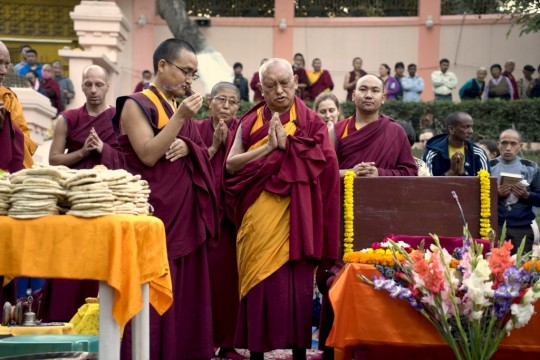
Lama Zopa Rinpoche, Mahabodhi Stupa, Bodhgaya, India, March 2015. Photo by Andy Melnic.
In the past, a student of Lama Zopa Rinpoche killed his parents during a psychotic episode. Rinpoche gave him practice advice then and later the student wrote back, “These days, I do practice as you advised me to: Vajrasattva practice, prostrations to the 35 Buddhas, listening to the Sanghata Sutra, reading the Diamond Cutter Sutra. I also do Tara and the two mantras plus one hour and thirty minutes of meditation on the cushion. For the 35 Buddhas, I don’t do prostrations because of physical problems; I only do the recitation with my hands folded. Is that good enough? Also, I’m asking if I can practice tantra now or not.”
My most dear, most kind, most precious one,
One very good thing is that when you put your hands together to prostrate, visualize your body huge like a mountain range and think that you are prostrating with many bodies from all ten directions to the lam-rim merit field which has the 35 Buddhas there. Or, just to the 35 Buddhas. Or, even just to Buddha, but, the numberless direct and indirect lineage lamas; the numberless deities of four classes of tantra; the thousand buddhas of this fortunate eon; the bodhisattvas; the 16 Arhats and so forth; the dakas and dakinis and Dharma protectors are all in the Buddha whose essence is the guru. One is many and many are one. Then, visualize bodies filling all the Earth prostrating from all directions, huge bodies like a mountain range. If you have received the initiation of 1000-Armed Chenrezig, you can visualize that, if not, then just your ordinary body. If you visualize like that, you get the same merit as having done that many prostrations with that many bodies. This is specific advice from Lama Tsongkhapa – the way to collect the most extensive merit.
Regarding your question on tantra, any of the lower tantra initiations are OK. That’s very good. And I want to say billion, trillion, zillion times thanks now that you have no fear and your mind is developed and you are making your life most beneficial – especially most beneficial for your parents – not only to be free from the oceans of samsaric suffering, but also to achieve the peerless happiness of enlightenment. It is so good that you are inspiring others and also inspiring your psychiatrist to learn meditation. I wish that all the people in the world who create negative karma like this would change and make their lives better, more meaningful for those people who get killed.
With much love and prayers,
Lama Zopa
Scribed by Ven. Sarah Thresher, Root Institute, Bodhgaya, India, March 2015. Edited by Mandala for inclusion on FPMT.org.
Learn more about Lama Zopa Rinpoche, spiritual director of the Foundation for the Preservation of Mahayana Tradition (FPMT), and Rinpoche’s vision for a better world. Sign up to receive news and updates.
27
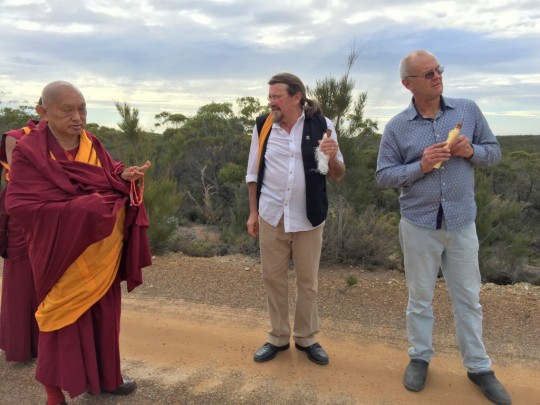
Lama Zopa Rinpoche looking around the De-Tong Ling Retreat Centre land with ex-director Kimball Cuddihy and present director Will Abram, Kangaroo Island, Australia, May 2015. Photo by Ven. Roger Kunsang.
Lama Zopa Rinpoche has arrived in Australia, starting his tour of the country with a visit to De-Tong Ling Retreat Centre on Kangaroo Island where he consecrated the Enlightenment Stupa and Padmasambhava statue there. Rinpoche will continue his tour teaching at Buddha House in Adelaide, Vajrayana Institute in Sydney, and Kusang Yeshe Retreat Centre in Katoomba.
These teachings will be webcast LIVE on FPMT’s Livestream page:
- May 30: Teaching on “Making the Most of your Life,” Buddha House, schedule to start at 7 p.m. Australian Central Standard Time (ACST)
- May 31: motivation for Medicine Buddha initiation (tentative), Buddha House, schedule to start at 7 p.m. ACST
- June 13: Teaching on “How to Apply Dharma in Daily Life,” Vajrayana Institute, scheduled 7 p.m. Australian Eastern Standard Time (AEST)
- June 14: Teaching on “The Joy of Compassion,” Vajrayana Institute, scheduled 7 p.m. AEST
- June 15: motivation for White Mahakala initiation (tentative), Vajrayana Institute, scheduled 7 p.m. AEST
- June 21: Long life puja, Vajrayana Institute, morning
Recordings of Rinpoche’s recent teachings in New Zealand are available as part of Rinpoche Available Now.
Higher quality recordings of all the teachings from Australia (including those from Kusang Yeshe Retreat Centre where livestreaming is impossible) will be made available at a later date on Rinpoche Available Now.
See Rinpoche’s Schedule for more details on upcoming teachings.
Lama Zopa Rinpoche is the spiritual director of the Foundation for the Preservation of Mahayana Tradition (FPMT), a Tibetan Buddhist organization dedicated to the transmission of the Mahayana Buddhist tradition and values worldwide through teaching, meditation and community service.
- Tagged: australia, lama zopa rinpoche, rinpoche available now, video
- 0
26
‘The Main Thing Now Is Attainment’
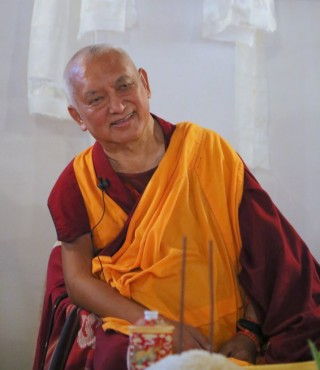
Lama Zopa Rinpoche, MAITRI Charitable Project, Bodhgaya, India, February 2015. Photo by Ven. Thubten Kunsang.
”We have achieved a lot in Dharma education and study,” Lama Zopa Rinpoche said in March 2015 while visiting Root Institute in India. “Now we have to put effort in attaining the path. I don’t mean just doing three-year retreat and counting a certain number of mantras, but attainment of the path through the lam-rim. Realizations don’t have to come from being in formal retreat. One can achieve them while working and studying with meditation on the lam-rim. One can be doing business and studying and meditating on the lam-rim. You can have a family and job and be meditating on the lam-rim. The main thing now is attainment.”
Scribed by Ven. Roger Kunsang. Edited by Mandala for inclusion on FPMT.org.
Learn more about Lama Zopa Rinpoche, spiritual director of the Foundation for the Preservation of Mahayana Tradition (FPMT), and Rinpoche’s vision for a better world. Sign up to receive news and updates.
25
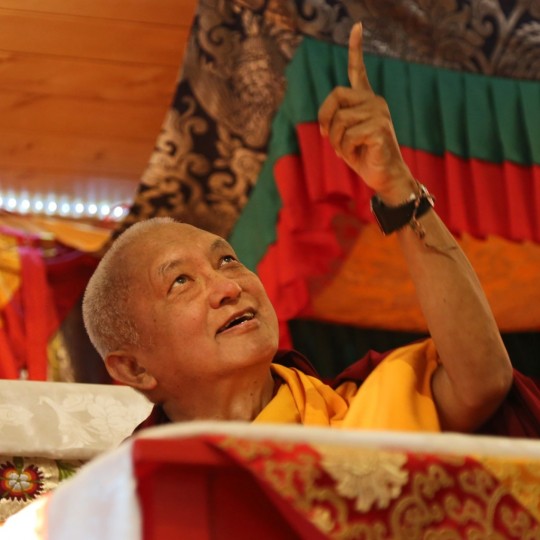
Lama Zopa Rinpoche, Chandrakirti Centre, Nelson, New Zealand, May 2015. Photo by Ven. Thubten Kunsang.
On May 16, Ven. Roger Kunsang shared this from Lama Zopa Rinpoche’s teachings at Chandrakirti Centre on his Twitter page:
Lama Zopa: Our self-cherishing mind is a dictator, like a guru we serve constantly.
Ven. Roger Kunsang, Lama Zopa Rinpoche’s assistant and CEO of FPMT Inc., shares Lama Zopa Rinpoche’s recent pith sayings on Ven. Roger’s Twitter page. (You can also read them on Ven. Roger’s Facebook page.)
Lama Zopa Rinpoche’s teachings at Chandrakirti Centre can be watched now on FPMT’s Livestream page.
For continuing updates and news from Kopan Monastery and other FPMT centers and projects in Nepal affected by the earthquake, please visit our “Updates from Nepal after the Earthquake” page:
https://fpmt.org/nepal-earthquake/
To learn more and offer support to the Nepal Earthquake Support Fund visit:
https://fpmt.org/support/socialservices/
For “Prayers and Practice for Earthquake in Nepal,” see:
https://fpmt.org/edu-news/prayers-and-practices-for-earthquake-in-nepal/
More information, photos and updates about FPMT spiritual director Lama Zopa Rinpoche can be found on Rinpoche’s homepage. If you’d like to receive news of Lama Zopa Rinpoche via email, sign up to Lama Zopa Rinpoche News.
- Tagged: lama zopa rinpoche, new zealand, twitter
- 0
22
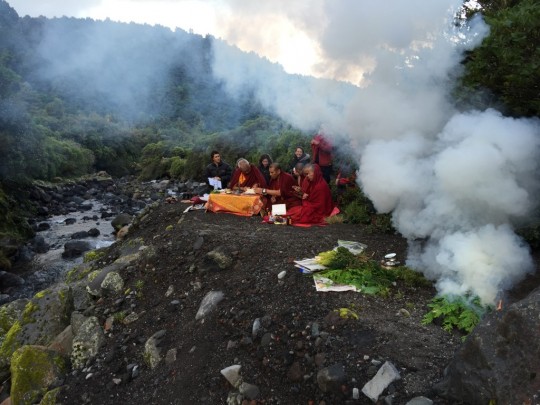
Incense puja at Mount Taranaki in New Zealand, May 2015. Lama Zopa Rinpoche has been wanting to do puja here for some years as is a special place. Photo by Ven. Roger Kunsang.
“So, why do we take refuge?,” Lama Zopa Rinpoche asked during a 2013 refuge ceremony at Amitabha Buddhist Centre in Singapore. “To be free from pervasive compounding suffering, from where the suffering of pain and the suffering of change arises – to be totally free from that, forever.
“To be able to help sentient beings, we have to be free from suffering. For example, if we are drowning in mud, how can we help others? If we are drowning in water, how can we help others? If we have no arms, how can we save others? To free ourselves from this suffering is not to achieve blissful peace for ourselves, but to help other sentient beings. The most important thing is to be able to help other sentient beings. We need to be free from suffering to do this.
“Just to be free from the lower realms, we don’t need to take refuge in Buddha, Dharma and Sangha. We don’t need these three. Even if we just remember a monk or nun – somebody we have devotion to – when we die, we will never get reborn in the lower realms at the time of death. Even if we remember one Sangha to whom we feel devotion, or if we think of the Heart Sutra, for example, or some mantra or prayer that we remember, we will never get reborn in lower realms.
“But to be free from samsara – from the pervasive compounding suffering – we need to take refuge. We need to take refuge in Buddha who revealed the path, who revealed the teaching, and the actual refuge. Buddha is like the doctor and Dharma is like the medicine. The actual refuge is Dharma, like the medicine for sickness. Then, the Sangha is like the nurse. The Sangha becomes an example, helping us actualize refuge, Dharma, within our heart. That is Sangha. We need all three to have refuge, to be free from the pervasive compounding suffering from where true suffering arises. Until we are free from this, we suffer in samsara constantly, endlessly, from beginningless rebirth. We can’t help sentient beings perfectly; we cannot help others perfectly without mistakes.”
Excerpted from “The Real Refuge” section of “Seeing How the I Exists” (http://bit.ly/seeing-how-the-i-exists) made available by the Lama Yeshe Wisdom Archive.
Learn more about Lama Zopa Rinpoche, spiritual director of the Foundation for the Preservation of Mahayana Tradition (FPMT), and Rinpoche’s vision for a better world. Sign up to receive news and updates.
- Tagged: lama yeshe wisdom archive, lama zopa rinpoche
- 0
21
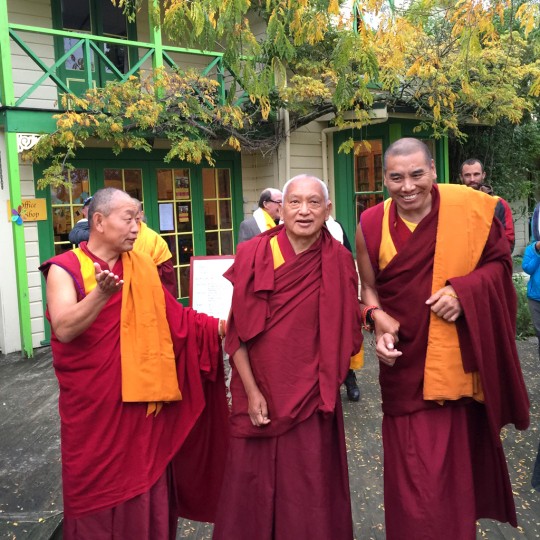
Lama Zopa Rinpoche with Geshe Thubten Wangchen and Geshe Jampa Tharchin at Chandrakirti Centre for the consecration of a Guru Rinpoche statue, Nelson, New Zealand, May 2015. Photo by Ven. Roger Kunsang.
“The wisdom realizing emptiness gives us the possibility to escape from problems forever,” said Lama Zopa Rinpoche in a 1990 teaching in Florence, Italy. “Achieving this ultimate happiness mainly depends on this realization. As I mentioned before, only the wisdom realizing emptiness can directly eradicate the ignorance which is the root of the whole samsaric suffering.Therefore, we should feel extremely fortunate and attempt to learn more, to listen, reflect and meditate more. As much as possible, in our everyday life we should attempt to meditate on emptiness even for a minute or a few seconds, especially once we have heard teachings that reveal the unmistaken view and we have some basic understanding of what ultimate nature means. Realizing emptiness gives us the opportunity to be free from the whole of samsara and all suffering.
“So, we should not waste time, we should not waste the opportunity. We must meditate as often as possible, even for a few seconds. We must meditate. Not meditating on emptiness, or not even remembering it for even one day is a great loss. Meditating on emptiness itself becomes great purification. For example, when it comes to purification methods in tantra and sutra, reading the Prajñaparamita teachings is one of the methods. Meditating on emptiness is one of the most powerful purifications.
“Even if you are doing Vajrasattva meditation, you are still advised to remember emptiness. The Vajrasattva recitation-purification becomes very powerful by remembering emptiness. Making offerings to these scriptures or copying them and meditating on them, are all regarded as very powerful purification practices. Anyway, you should not waste the opportunity, especially if you have studied these teachings and have some basic understanding of them. Even rising doubts about emptiness has a great effect – it shatters samsara into pieces.”
Excerpted from “Meditation on Emptiness and Tong-len (Taking and Giving)” (http://bit.ly/meditation-on-emptiness-and-tong-len) made available by the Lama Yeshe Wisdom Archive.
Learn more about Lama Zopa Rinpoche, spiritual director of the Foundation for the Preservation of Mahayana Tradition (FPMT), and Rinpoche’s vision for a better world. Sign up to receive news and updates.
- Tagged: lama yeshe wisdom archive, lama zopa rinpoche
- 0
20
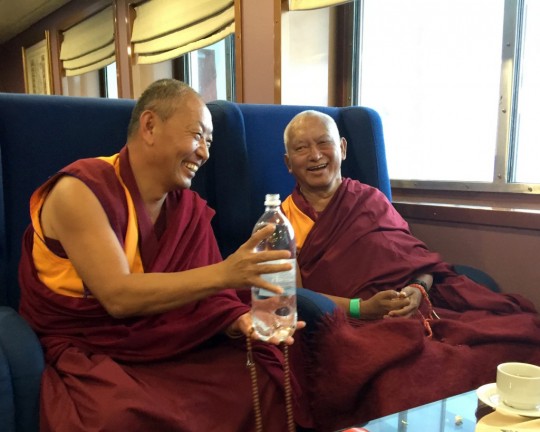
Lama Zopa Rinpoche with Geshe Thubten Wangchen from Dorje Chang Institute blessing water with students to pour from the boat into the strait between the north and south islands of New Zealand, May 2015. Photo by Ven. Thubten Kunsang.
Lama Zopa Rinpoche returns to New Zealand’s North Island to continue his teaching tour. Rinpoche’s teachings in Auckland at Dorje Chang Institute will be webcast LIVE on FPMT’s Livestream page:
- May 22: Teaching on How to Have a Happy, Meaningful Life, schedule to start at 7 p.m. New Zealand time
- May 23: Teaching on How to Have a Happy, Meaningful Life, scheduled 4 – 7 p.m. New Zealand time
- May 25: A Chat about Death, approximately 3 – 5 p.m. New Zealand time
Recordings of Rinpoche’s teachings at Mahamudra Centre and Chandrakirti Centre can be watched now on Livestream.
Higher quality recordings will be made available at a later date on Rinpoche Available Now.
See Rinpoche’s Schedule for more details on upcoming teachings.
Lama Zopa Rinpoche is the spiritual director of the Foundation for the Preservation of Mahayana Tradition (FPMT), a Tibetan Buddhist organization dedicated to the transmission of the Mahayana Buddhist tradition and values worldwide through teaching, meditation and community service.
- Tagged: lama zopa rinpoche, new zealand
- 0
- Home
- News/Media
- Study & Practice
- About FPMT Education Services
- Latest News
- Programs
- New to Buddhism?
- Buddhist Mind Science: Activating Your Potential
- Heart Advice for Death and Dying
- Discovering Buddhism
- Living in the Path
- Exploring Buddhism
- FPMT Basic Program
- FPMT Masters Program
- FPMT In-Depth Meditation Training
- Maitripa College
- Lotsawa Rinchen Zangpo Translator Program
- Universal Education for Compassion & Wisdom
- Online Learning Center
- Prayers & Practice Materials
- Overview of Prayers & Practices
- Full Catalogue of Prayers & Practice Materials
- Explore Popular Topics
- Benefiting Animals
- Chenrezig Resources
- Death & Dying Resources
- Lama Chopa (Guru Puja)
- Lama Zopa Rinpoche: Compendium of Precious Instructions
- Lama Zopa Rinpoche: Life Practice Advice
- Lama Zopa Rinpoche Practice Series
- Lamrim Resources
- Mantras
- Prayer Book Updates
- Purification Practices
- Sutras
- Thought Transformation (Lojong)
- Audio Materials
- Dharma Dates – Tibetan Calendar
- Translation Services
- Publishing Services
- Teachings and Advice
- Find Teachings and Advice
- Lama Zopa Rinpoche Advice Page
- Lama Zopa Rinpoche: Compendium of Precious Instructions
- Lama Zopa Rinpoche Video Teachings
- ༧སྐྱབས་རྗེ་བཟོད་པ་རིན་པོ་ཆེ་མཆོག་ནས་སྩལ་བའི་བཀའ་སློབ་བརྙན་འཕྲིན།
- Podcasts
- Lama Yeshe Wisdom Archive
- Buddhism FAQ
- Dharma for Young People
- Resources on Holy Objects
- Ways to Offer Support
- Centers
- Affiliates Area
- Teachers
- Projects
- Charitable Projects
- Make a Donation
- Applying for Grants
- News about Projects
- Other Projects within FPMT
- Support International Office
- Projects Photo Galleries
- Give Where Most Needed
- FPMT
- Shop
Translate*
*powered by Google TranslateTranslation of pages on fpmt.org is performed by Google Translate, a third party service which FPMT has no control over. The service provides automated computer translations that are only an approximation of the websites' original content. The translations should not be considered exact and only used as a rough guide.If we want to understand how we are ordinarily misled by our false projections and how we break free from their influence, it is helpful to think of the analogy of our dream experiences. When we wake up in the morning, where are all the people we were just dreaming about? Where did they come from? And where did they go? Are they real or not?







